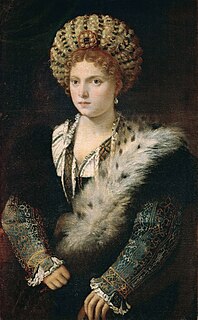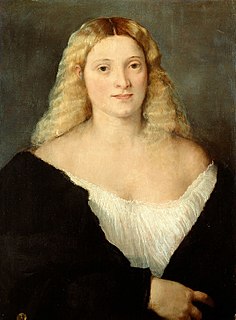
Pieter Bruegelthe Elder was the most significant artist of Dutch and Flemish Renaissance painting, a painter and printmaker, known for his landscapes and peasant scenes ; he was a pioneer in making both types of subject the focus in large paintings.

The Kunsthistorisches Museum is an art museum in Vienna, Austria. Housed in its festive palatial building on Ringstraße, it is crowned with an octagonal dome. The term Kunsthistorisches Museum applies to both the institution and the main building. It is the largest art museum in the country and one of the most important museums worldwide.

Margaret Theresa of Spain was, by marriage to Leopold I, Holy Roman Empress, German Queen, Archduchess of Austria and Queen of Hungary and Bohemia. She was the daughter of King Philip IV of Spain and the elder full-sister of Charles II, the last of the Spanish Habsburgs. She is the central figure in the famous Las Meninas by Diego Velázquez, and the subject of many of his later paintings.

Infanta Margarita Teresa in a Blue Dress is one of the best-known portraits by Spanish painter Diego Velázquez. Executed in oil on canvas, it measures 127 cm high by 107 cm wide and was one of Velázquez's last paintings, produced in 1659, a year before his death. It shows Margaret Theresa of Spain who also appears in the artist's Las Meninas. Currently, the painting is in the Kunsthistorisches Museum.

Self Portrait is an oil on canvas painting by the Dutch artist Rembrandt. Painted in 1652, it is one of over 40 painted self-portraits by Rembrandt, and was the first he had painted since 1645. In composition it is different from his previous self-portraits, depicting the painter in a direct frontal pose, hands on his hips, and with an air of self-confidence. It was painted the year that his financial difficulties began, and breaks with the sumptuous finery he had worn in previous self-portraits. Art historian Christopher White has called it "one of the most magisterial and sombre of these (late) pictures". It is in the Kunsthistorisches Museum in Vienna.

Isabella in Black is a portrait of a young woman by Titian. It can be dated to the 1530s and is in the Kunsthistorisches Museum in Vienna. The artist and the date are undisputed. Beyond the museum documentaton, there are repeated doubts about the person depicted.

Madonna with Child Enthroned between Saints John the Baptist and Sebastian is a painting by the Italian Renaissance artist Pietro Perugino, executed in 1493, and housed in the Uffizi Gallery, Florence.

Lucretia and her Husband Lucius Tarquinius Collatinus or Tarquin and Lucretia is an oil painting attributed to Titian, dated to around 1515 and now in the Kunsthistorisches Museum in Vienna. The attribution to this artist is traditional but uncertain - the brightened palette suggests it could instead be by Palma Vecchio. However, others identify the painting as part of Titian's series of half-length female figures from 1514 to 1515, which also includes the Flora at the Uffizi, the Woman with a Mirror at the Louvre, the Violante and the Young woman in a black dress in Vienna, Vanity in Munich and the Salome at the Galleria Doria Pamphilj. There is an early copy in the Royal Collection.

The Young Woman in a Black Dress is an oil painting by Titian, dating to around 1520 and now held at the Kunsthistorisches Museum in Vienna. It was later misattributed to Palma il Vecchio, then to Giovanni Cariani, until Roberto Longhi reattributed it as by Titian, which is now the critical consensus.

Adam and Eve is a pair of paintings by German Renaissance master Lucas Cranach the Elder, dating from 1528, housed in the Uffizi, Florence, Italy. There are other paintings by the same artist with the same title, depicting the subjects either together in a double portrait or separately in a pair of portraits, for instance at the Kunsthistorisches Museum in Vienna, the Courtauld Gallery in London, the Museum der bildenden Künste in Leipzig, and the Art Institute of Chicago.

Shepherd with a flute, or Boy with a Pipe, is a painting in oil on canvas of perhaps 1510–1515, in recent decades usually attributed to Titian, though in the past often to Giorgione. It is now in the Royal Collection, and in 2018 was in the King's Closet at Windsor Castle. Since at least 1983 it has been called Boy with a Pipe by the Royal Collection; previous titles the collection recognise include Shepherd with a pipe, and The Shepherd.

The Portrait of Infanta Isabella Clara Eugenia is a painting by Rubens of Isabella Clara Eugenia. It is dated to 1625 and shows her in the habit of the Poor Clares, which she assumed on 22 October 1621 after the death of her husband Archduke Albert of Austria. She visited the painter's studio while on her way back from Breda in 1625 to see the painting begun, as a master copy from which several others could be drawn. The master copy is now in the Galleria Palatina in Florence, having been traded in the past for a portrait of the same subject by Anthony van Dyck. Two other copies are known in private collections, while a third is in the Norton Simon Museum in Pasadena.

The Ildefonso Altarpiece is a triptych painting by Peter Paul Rubens, dating to between 1630 and 1631. It is now in the Kunsthistorisches Museum, in Vienna.

The Vision of the Blessed Hermann Joseph or The Mystical Engagement of the Blessed Hermann Joseph to the Virgin Mary is a 1629–1630 painting by the Flemish Baroque painter Anthony van Dyck.

Thetis Receiving the Weapons of Achilles from Hephaestus is a 1630-1632 painting by the Flemish painter Anthony van Dyck. It was acquired by Archduke Leopold Wilhelm of Austria and is now in the Kunsthistorisches Museum in Vienna. It illustrates the story of the Shield of Achilles, from the Iliad, Book 18, lines 478–608, in which Thetis requests replacement weapons and shield for her son Achilles from Hephaestus.

The Bravo is an oil painting usually attributed to Titian, dated to around 1516-17 and now in the Kunsthistorisches Museum in Vienna. The painting can be seen as one of a number of Venetian paintings of the 1510s showing two or three half-length figures with heads close together, often with their expressions and interactions enigmatic. Most of these are "Giorgionesque" genre or tronie subjects where the subjects are anonymous, though the group includes Titian's The Tribute Money, with Christ as the main figure, which in terms of style is similar to this painting, and his Lucretia and her Husband, also in Vienna, where at least the woman's identity is clear, if not that of the man.

Bartolomeo della Nave was a Venetian merchant and art collector.

Christ on the Cross with Mary and St John is a c.1443-1445 altarpiece by Rogier van der Weyden, now in the Kunsthistorisches Museum in Vienna. The central scene shows the Crucifixion of Jesus, with the Virgin Mary clinging to the foot of the cross, John the Evangelist comforting her and the painting's two donors kneeling to the right. On the left hand side panel is Mary Magdalene, whilst on the right side panel is St Veronica. A unified landscape background across all three panels shows Jerusalem in the distance.

The Ca' Dolfin Tiepolos are a series of ten oil paintings made c.1726–1729 by Giovanni Battista Tiepolo for the main reception room or salone of the Palazzo Ca' Dolfin, the palazzo of the patrician Dolfin family in Venice. The paintings are theatrical depictions of events from the history of Ancient Rome, with a typically Venetian emphasis on drama and impact rather than historical accuracy. They were painted on shaped canvases and set into the architecture with frescoed surrounds.

Judith with the Head of Holofernes is a 1575–1580 oil on canvas painting by Paolo Veronese. It entered the collection of Archduke Leopold Wilhelm of Austria in 1659 and is now in the Kunsthistorisches Museum in Vienna.




















